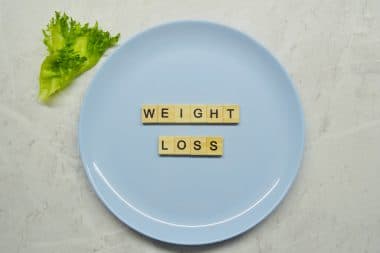The Battle of the Bulge
Unwanted weight gain takes many people by surprise. It is relatively easy not to think about the consequences of what you are eating when you are indulging in your favorite foods. One day you step onto your bathroom scales and are shocked by the number staring back at you. You vow to go on a diet to lose the weight. Six weeks later, after faithfully dieting, you begin to wonder why you aren’t losing the weight as fast as you thought you should. What are you doing wrong?
Understanding How Weight Gain Happens
Anytime you take in more calories than your body needs to function, the excess calories are stored as fat in your body. For example, if you eat a 2,500 calorie diet each day, but your body only needs 1,800 calories to function, the extra 700 calories are stored as fat. By the end of the week, that translates into 4,900 extra calories. It takes 3,500 calories to equal 1 pound. That extra 700 calories a day works out to a little over 1 1/2 pounds of weight gain in a week. Modifying your food intake by dieting can, and will, help you lose weight. Adding daily exercise to your dieting routine will help you lose weight faster.
How Does Exercise Help With Weight Loss?
Your body burns the calories you eat to create the energy it needs. If you normally eat 2,000 calories a day and your activity level only requires 2,000 calories worth of energy, your weight remains stable. If you eat 2,000 calories and your activity level requires 2,500 calories worth of energy, then your body will begin to burn fat in order to access the energy stored in the fat cells. The more you exercise, the more fat your body can convert to needed energy.
What Are The Best Exercises For Weight Loss?
While all exercise can help contribute to weight loss, moderate to high intensity exercise will help accelerate the process. 30 minutes of jogging will burn more fat than 30 minutes of leisurely walking. Choose exercises that you enjoy performing. While jogging may burn more calories, if you hate jogging and avoid it like the plague, it won’t do you any good. It is more important to perform 30 minutes a day of exercises you like than struggling to do 15 minutes a week exercises you hate.
How Much Weight Can You Expect to Lose Per Week by Exercising?
The Centers for Disease Control and Prevention suggests setting a target weight loss goal of 1 to 2 lbs. per week. This is a good target to aim for, as it gives you the best chance of not only losing weight, but successfully keeping off in the long term.
Important Exercise Terms to Know
It can seems as if weight loss and exercise have their own separate language. Understanding the some of the terms used to describe different work out routines and other fitness-related terms is important for putting together the best workout for your weight loss goals. Here are a few of the terms you should become familiar with:
1. Aerobic Exercise
Any physical exercise that raises your heart rate and keeps it elevated in order to burn calories. It is also referred to as “Cardio.” Aerobic exercise works your larger muscles, such as your legs. It also raises your respiratory rate, providing your muscles with the oxygen they need to burn fat. Some examples of Aerobic exercise include running, jogging, dancing, biking, jumping, and swimming.
2. HIIT (High Intensity Interval Training)
Short bursts of high intensity exercise followed by sets of lower intensity exercise are collectively known as High Intensity Interval Training,or “HIIT.” HIIT increases the amount of fat your body burns. Because this type of training requires your body to work harder for shorter periods of time, the body also has to work harder to resume normal levels of activity. HIIT creates an environment in which your body is constantly burning fat throughout the day. An example of HIIT would be running as fast as you can for 30 seconds, followed by walking at a leisurely pace for 1 minute, followed by another 30 seconds of fast running.
3. BMI
BMI, or Body Mass Index, is a weight management tool. It uses a standard formula based on your height and your weight to measure your mass. While not very accurate for highly athletic people, most of us don’t fall into that category. A BMI greater than 25 means your heart has to work harder to circulate blood through your system and is considered overweight, a BMI over 30 is considered obese. Calculate your BMI here
4. Warm Up/Cool Down Exercises
It is important to remember to warm up your muscles before working out, in order to help prevent injury. This involves taking 30 minutes before beginning your workout routine to gently stretch your muscles. It is also important to gradually stretch after your workout, known as “cooling down”, to help prevent post-workout soreness and muscle cramping.
What is meant by “Water Weight?”
When you first begin your weight loss routine, it is not uncommon to lose 4 or 5 lbs in the first week. Seeing your numbers dropping that much in such a short amount of time makes you feel great, but you should understand what is actually happening in your body that causes those initial pounds to magically melt away.
Sodium is responsible for water-retention. It occurs when the kidneys can not efficiently flush excess sodium out of the body. This excess sodium is what causes you to feel bloated, uncomfortable, and to notice your weight has increased by a few pounds on your bathroom scale.
When you start to eat a healthier, more balanced daily diet, you are also consuming a lot less sodium. Your kidneys are better able to flush any excess sodium out of your system, and work more effectively. These diet changes, combined with the sweat loss experienced during exercise, are responsible for the first 3-5 lbs. of weight that you lose. After you have been dieting and exercising for a little while, your body settles into a more stable weigh loss pattern, averaging the recommended rate of 1 to 2 lbs a week.
You’ve Been Working Out Faithfully For Weeks. Why Has Your Weight Loss Slowed Down?
It happens without fail: The first few weeks of your new workout routine, it seemed that losing weight was almost effortless. Each time you stepped up onto the scales, the weight seemed to simply disappeared. Now here you are, 4 weeks later, and each time you weigh yourself, the scale seems to barely move. What is happening?
You may have reached what is commonly known as a weight loss “plateau.” A plateau is what happens when you are trying to reach your weight loss goal, but can’t seem to quite get there. For example, if your targeted weight loss goal is to reach 130 lbs, but you seem to be stuck at 140 lbs, you may have reached a plateau.
As you lose weight, you have less lean muscle. The lower your lean muscle mass is, the less energy is need for it to function. This means less fat is burned for energy. This causes changes in your body’s metabolism rate. The end result is a slowing of your weight loss.
Making regularly scheduled changes to your exercise routine can help break plateaus. The more often you change up your routine, the less likely it is for your metabolism to get stuck in a “fat-burning rut.” Instead of doing the exact same exercises, in the exact same order, at the exact same intensity level, week in and week out, try changing things up a bit. HIIT workouts are great for breaking through plateaus.
Taking A Closer Look At Your Bathroom Scales
When you are trying to lose weight, it is easy to focus solely on what the bathroom scales say about your weight. It is important to know that the number on the scale is not the only indicator of your weight loss success. Sometimes, it is not even the best indicator of how fit you are.
If you exercise and look toned and trim, but your scale still says you are 15 lbs. away from your targeted weight, it is better to judge your success by what you see in the mirror and how you feel instead of becoming a slave to a predetermined number on the scales. There are many factors to consider when determining your fitness level. After you’ve been exercising for awhile, and are starting to notice positive changes in your body, ask yourself these questions:
How do you feel?
Are you sleeping better?
Have your flexibility and endurance increased?
How is your overall health?
Is your appetite under better control?
Are you noticing a new tight and toned look to your muscles?
Do your clothes fit better?
How satisfied are you with your appearance?
How you answer these questions will give you more feedback about the effectiveness of your weight loss routine than relying only on what your scale says.
A good way to gauge your weight loss is to take before, during, and after measurements of your arms, chest, waist, hips, thighs, and calves. Measuring these areas before you begin an exercise routine will give you a baseline measurement to compare your exercising efforts against. As your measurements change, you will begin to notice these changes translate into a leaner, trimmer, healthier “You.”
A Few Key Things To Remember When Exercising To Lose Weight
Keep in mind that weight doesn’t look the same on everyone. 130 lbs. on someone who is 5’7″ tall will look differently than it does on someone who is 5’5″ tall, depending on a number of factors, including how it is carried on the body.
Muscle is more dense than fat (20% smaller by weight). That is why 2 people can weigh 145 lbs., but look completely different. One looks toned and healthy because they exercise to lose fat, and the other may look out of shape because of excessive fat.
Remember to stay hydrated. Drink plenty of water while exercising. As your body breaks down and burns fat, your kidneys need water to help flush the molecular by-products out of your body. Dehydration will also slow your weigh loss.
You Can Do This!
Losing weight successfully take determination, commitment and effort. Find an exercise routine you enjoy doing and that works for your weight loss goals. Stick with it! Before you know it, you will see a leaner version of yourself.
Remember this: You only have one body. You owe it to yourself to take good care of it by getting into the best shape possible. It’s the best gift you can give yourself.







